Table of Contents
- Introduction
- Editor’s Choice
- MFA Market Overview
- Password Security Issues Driving the Demand for MFA
- Multi-Factor Authentication Adoption Statistics
- Commonly Used Multi-Factor Authentication Methods
- Multi-Factor Authentication Usage in Organizations
- Latest Multi-Factor Authentication Trends Statistics
- Multi-Factor Authentication Challenges Statistics
- Recent Developments
- Conclusion
- FAQs
Introduction
Multi-Factor Authentication Statistics: Multi-factor authentication (MFA) is an essential security measure that strengthens access control by insisting that users provide at least two types of authentication, like passwords and mobile codes.
It plays a critical role in safeguarding digital information in our interconnected world, enhancing security by reducing vulnerabilities associated with single-factor authentication and preventing unauthorized access attempts.
While it offers advantages such as improved security and compliance, successful implementation is required. A careful balance between security and user convenience, as well as addressing potential challenges.
In summary, MFA is a central component of today’s cybersecurity landscape. Serving as a protective barrier against unauthorized access and data breaches.
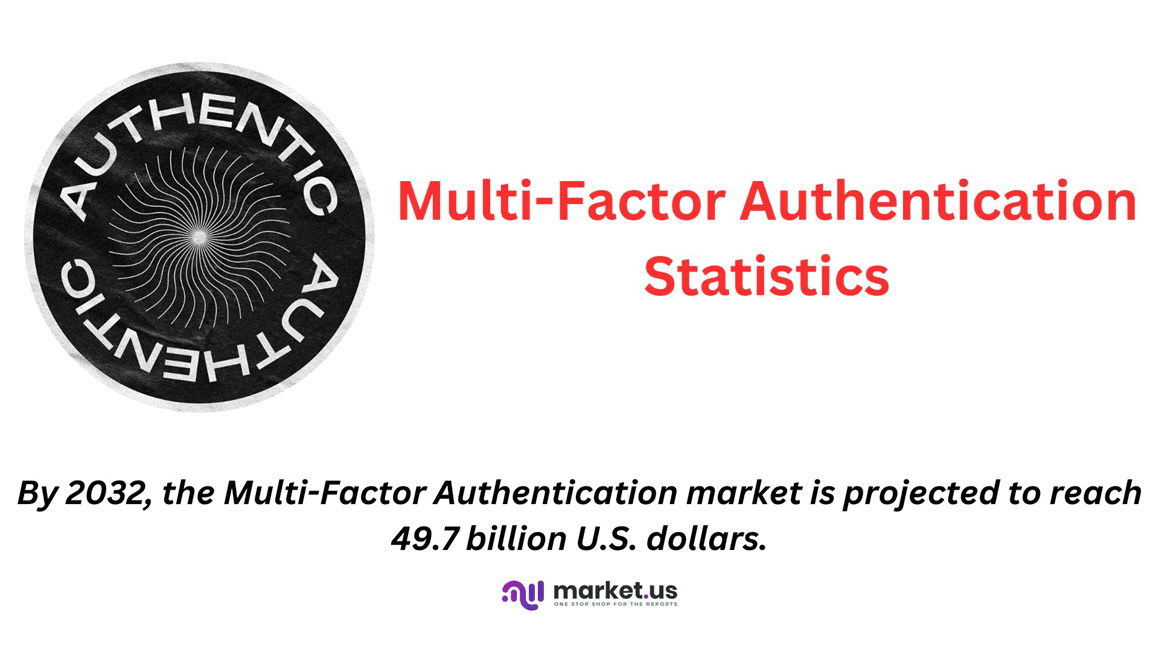
Editor’s Choice
- In 2023, the Multi-Factor Authentication market generated USD 14.4 billion in revenue.
- Large enterprises dominate the enterprise landscape, holding a substantial 64% market share. These organizations, often with extensive resources and complex security needs. These are at the forefront of adopting MFA solutions to safeguard their digital assets and sensitive information.
- As per findings from LastPass, in 2019, MFA usage in businesses globally saw a notable uptick, with 57% of them incorporating it into their security practices, marking a 12% increase from the preceding year.
- According to the Okta Secure Sign-In Trends Report, push notifications emerged as the most commonly employed MFA method, followed by SMS notifications and soft tokens.
- Notably, the technology sector led the way in MFA and 2FA adoption, with a robust 87% of organizations implementing these security measures.
- In 2021, the worldwide landscape of Multi-Factor Authentication (MFA) methods saw notable preferences among users, with smartphone-based authentication emerging as the most convenient choice, commanding a significant 73% usage rate.
- When it comes to MFA usage among employees, a substantial 95% opt for software-based solutions, predominantly mobile apps.
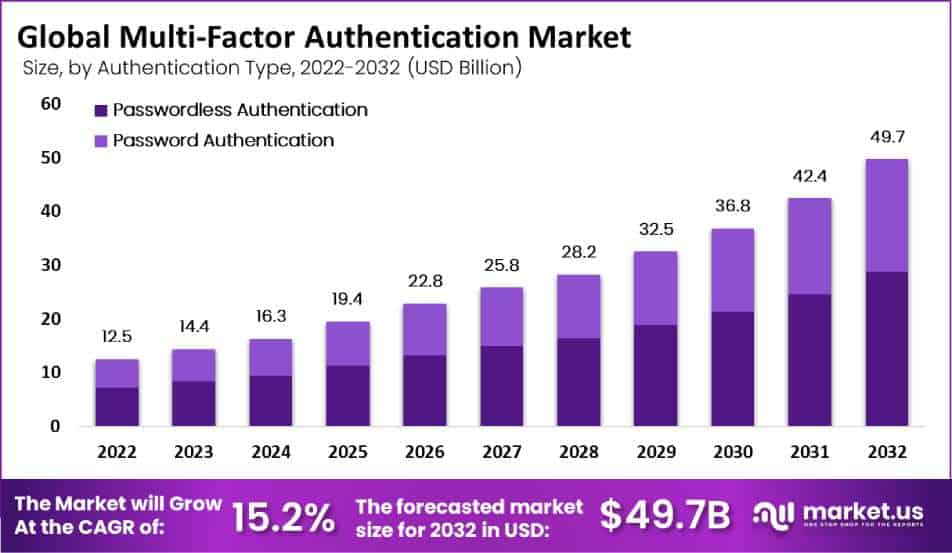
MFA Market Overview
Global Multi-Factor Authentication Market Size Statistics
- The global Multi-Factor Authentication (MFA) market has been experiencing significant revenue growth over the past decade at a CAGR of 15.2%.
- In 2022, the market generated USD 12.5 billion in revenue, and this upward trajectory is expected to continue.
- In 2023, the revenue increased to USD 14.4 billion, followed by a further rise to USD 16.3 billion in 2024.
- The MFA market is projected to see continuous expansion in the coming years, with revenue estimates of USD 19.4 billion in 2025, USD 22.8 billion in 2026, and USD 25.8 billion in 2027.
- As we move towards 2028 and 2029, the market is anticipated to reach USD 28.2 billion and USD 32.5 billion, respectively.
- Looking ahead to 2030 and beyond, the MFA market is poised for substantial growth, with revenue projections of USD 36.8 billion in 2030, USD 42.4 billion in 2031, and an impressive USD 49.7 billion in 2032.
- This remarkable expansion in MFA market revenue reflects the increasing importance of security measures in various industries, driving the demand for multi-factor authentication solutions.
(Source: Market.us)
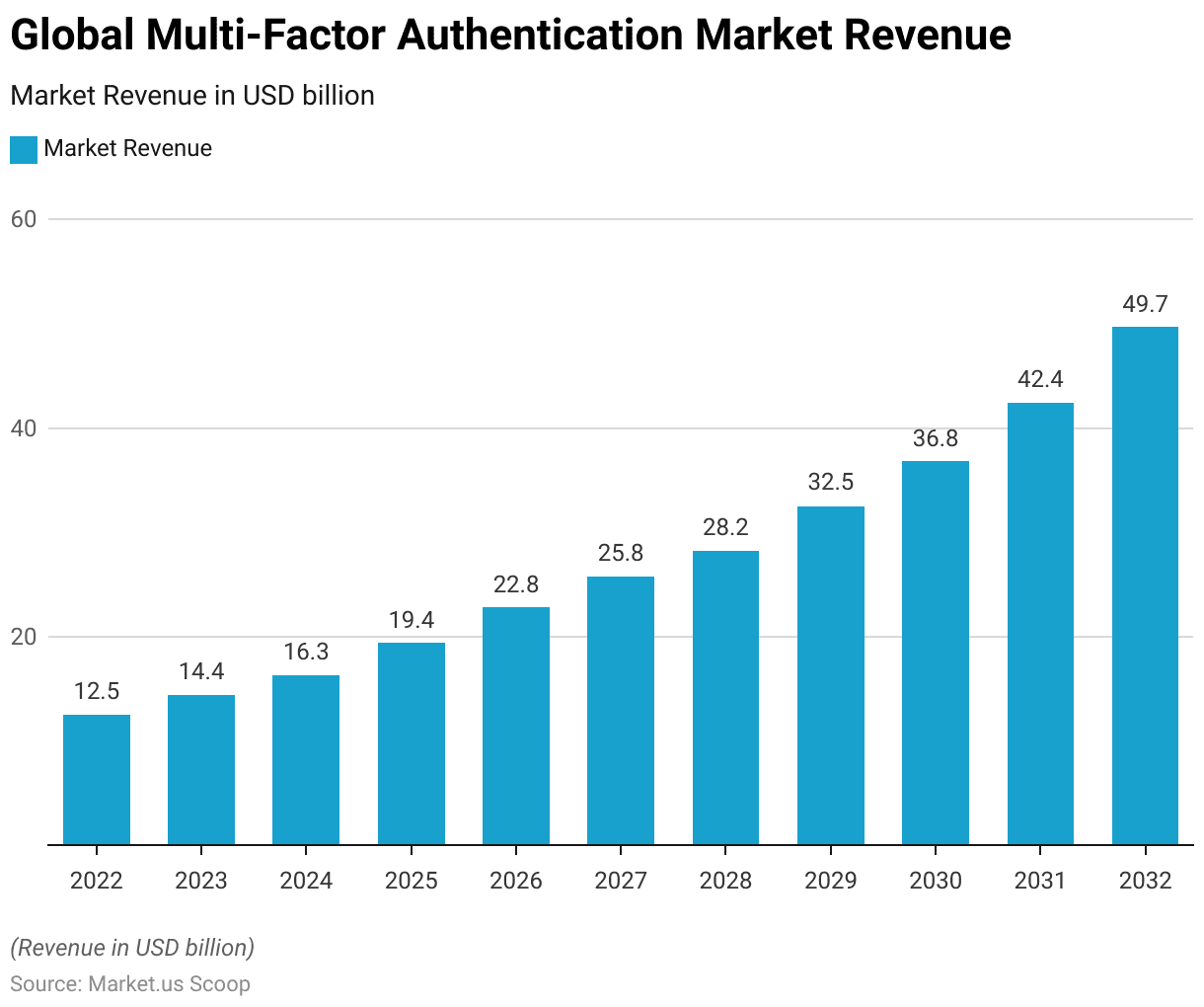
Multi-Factor Authentication Market Size – By Authentication Type Statistics
- The Global Multi-Factor Authentication (MFA) market exhibits a robust growth trajectory, with a focus on different authentication types. Namely Password Authentication and Password-less Authentication.
- In 2022, the total MFA market revenue stood at USD 12.5 billion. Within this, Password Authentication accounted for USD 7.3 billion, while Password-less Authentication contributed USD 5.3 billion.
- As we progress through the years, the market witnesses substantial expansion. In 2023, the total MFA market revenue increased to USD 14.4 billion, with Password Authentication generating USD 8.4 billion and Password-less Authentication reaching USD 6.0 billion.
- The trend continues with revenue figures of USD 16.3 billion for the total MFA market in 2024. Comprising USD 9.5 billion from Password Authentication and USD 6.8 billion from Password-less Authentication.
- This growth pattern persists, with revenue estimates projecting the total MFA market to reach USD 49.7 billion in 2032, of which Password Authentication is expected to contribute USD 28.8 billion, and Password-less Authentication is set to reach USD 20.9 billion.
- This data underscores the increasing importance of multi-factor authentication in enhancing security across various sectors, with both traditional and password-less methods playing a pivotal role in safeguarding digital assets.
(Source: Market.us)

Global Multi-Factor Authentication Market Share – By Enterprise Size Statistics
- In the Global Multi-Factor Authentication (MFA) market, the distribution of market share varies significantly based on the size of enterprises.
- Large enterprises dominate this landscape, holding a substantial 64% market share. These organizations, often with extensive resources and complex security needs, are at the forefront of adopting MFA solutions to safeguard their digital assets and sensitive information.
- On the other hand, small enterprises also play a significant role, accounting for 36% of the market share. Despite their relatively smaller size, these businesses recognize the importance of robust security measures provided by MFA to protect their operations from potential threats.
- This division in market share reflects the wide-ranging appeal and adoption of MFA solutions across enterprises of different sizes. Highlighting the industry’s commitment to bolstering cybersecurity measures in both large and small-scale business environments.
(Source: Market.us)
Take advantage of our unbeatable offer - buy now!

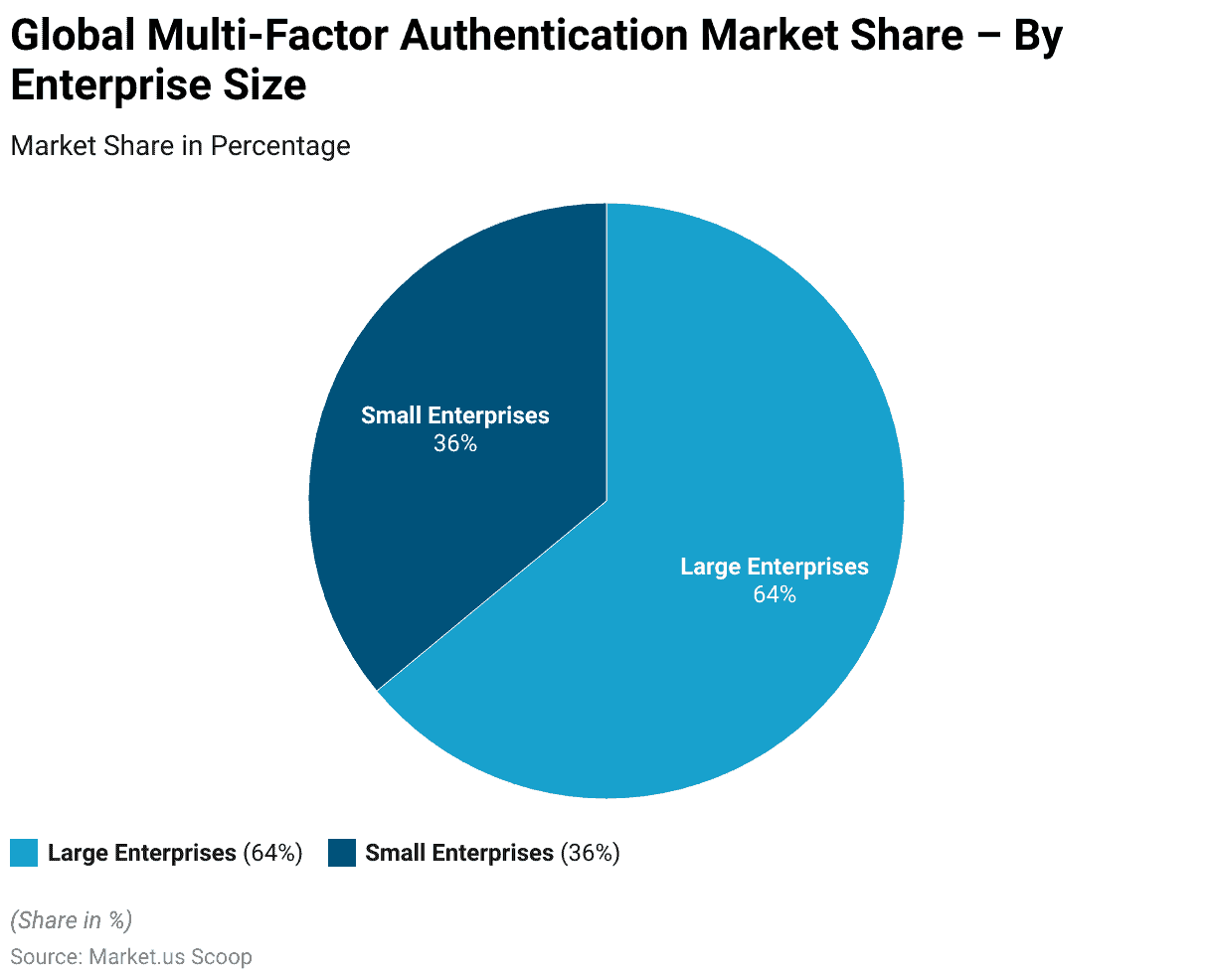
Password Security Issues Driving the Demand for MFA
- The Workplace Password Malpractice Report highlights a troubling pattern in password security, underscoring the urgent need for stronger measures.
- It reveals that many people continue to use overly simple and easily guessable passwords like “123456,” “123456789,” “qwerty,” “password,” and “12345,” which poses a significant security risk.
- The study also unveils that 57% of individuals resort to jotting down their passwords on sticky notes, and out of these, 67% confess to losing these notes, thereby increasing the risk of unauthorized access.
- Additionally, 62% of people store passwords in physical notebooks, often left exposed, such as near their work devices.
- Concerns also arise with digital password storage practices. The report finds that 49% of individuals save work-related passwords in cloud-based documents, and 51% store them in documents on their computers.
- Furthermore, 55% of people store passwords on their mobile phones. A practice that could lead to security breaches if these devices are lost or compromised.
- These findings underscore the vulnerability of relying solely on passwords for account security. To address these issues, it is strongly recommended to implement multi-factor authentication (MFA) as an effective countermeasure.
(Source: Workplace Password Malpractice Report)
Multi-Factor Authentication Adoption Statistics
- As per findings from LastPass, in 2019, MFA usage in businesses globally saw a notable uptick, with 57% of them incorporating it into their security practices, marking a 12% increase from the preceding year.
- Moreover, the adoption of 2FA demonstrated substantial growth, surging by 51% from 2017 to 2021.
- However, according to the Global Small Business Multi-Factor Authentication (MFA) Study by the Cyber Readiness Institute. The scenario among small to medium-sized businesses (SMBs) is less encouraging, with 54% of them not implementing MFA at all, and a mere 28% making it a mandatory security measure.
- Interestingly, Okta’s recent Secure Sign-In Trends Report revealed that, somewhat surprisingly. Highly regulated industries and large enterprises exhibited a slower pace in embracing MFA compared to other sectors.
- According to the Okta Secure Sign-In Trends Report, push notifications emerged as the most commonly employed MFA method, followed by SMS notifications and soft tokens.
- Notably, the technology sector led the way in MFA and 2FA adoption, with a robust 87% of organizations implementing these security measures.
- In contrast, the transportation and warehouse industries showed the lowest enthusiasm for MFA, with adoption rates standing at only 39%. Moreover, administrators demonstrated a higher rate of MFA adoption compared to non-administrative users.
(Source: LastPass, Cyber Readiness Institute, Okta)
Multi-Factor Authentication Adoption – By Industry Statistics
- The adoption of Multi-Factor Authentication (MFA) varies across different industries, reflecting varying levels of emphasis on cybersecurity.
- In the technology sector, MFA adoption stands at a robust 87%, highlighting the industry’s commitment to safeguarding sensitive data and intellectual property.
- Insurance follows closely behind with a 77% adoption rate, indicating the recognition of the importance of MFA in protecting sensitive customer information and financial data.
- Professional services and education sectors demonstrate significant adoption as well, with adoption rates of 75% and 64%, respectively.
- In the finance and banking industry, where stringent security measures are paramount, MFA adoption reaches 60%.
- Healthcare and government sectors exhibit slightly lower adoption rates, with 56% and 48%, respectively.
- These variations in adoption percentages reflect the diverse cybersecurity priorities and regulatory requirements within each industry. Emphasizing the critical role that MFA plays in enhancing data protection across various sectors.
(Source: Okta)
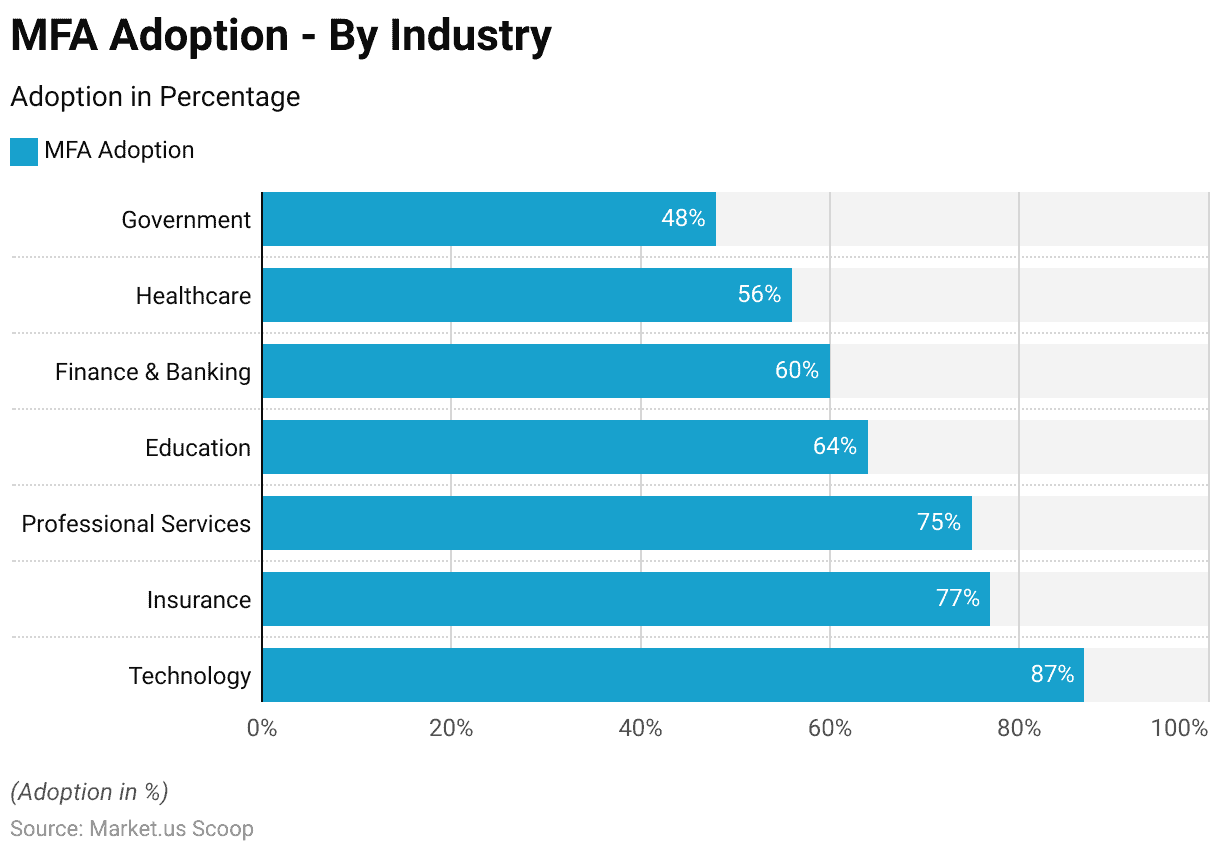
Commonly Used Multi-Factor Authentication Methods
- In 2021, the worldwide landscape of Multi-Factor Authentication (MFA) methods saw notable preferences among users, with smartphone-based authentication emerging as the most convenient choice, commanding a significant 73% usage rate.
- Leveraging the capabilities of smartphones for authentication purposes offers a seamless and accessible way to enhance security.
- Additionally, built-in authenticators like TouchID and Windows Hello accounted for 17% of MFA adoption, providing users with the convenience of biometric authentication integrated into their devices.
- A smaller yet notable portion of users, constituting 5%, opted for MFA methods involving a smart card or a U2F security key, such as Yubikey.
- These choices underline the global recognition of the importance of MFA in fortifying digital security, with users selecting methods that align with their preferences for ease of use and robust protection against unauthorized access.
(Source: Statista)
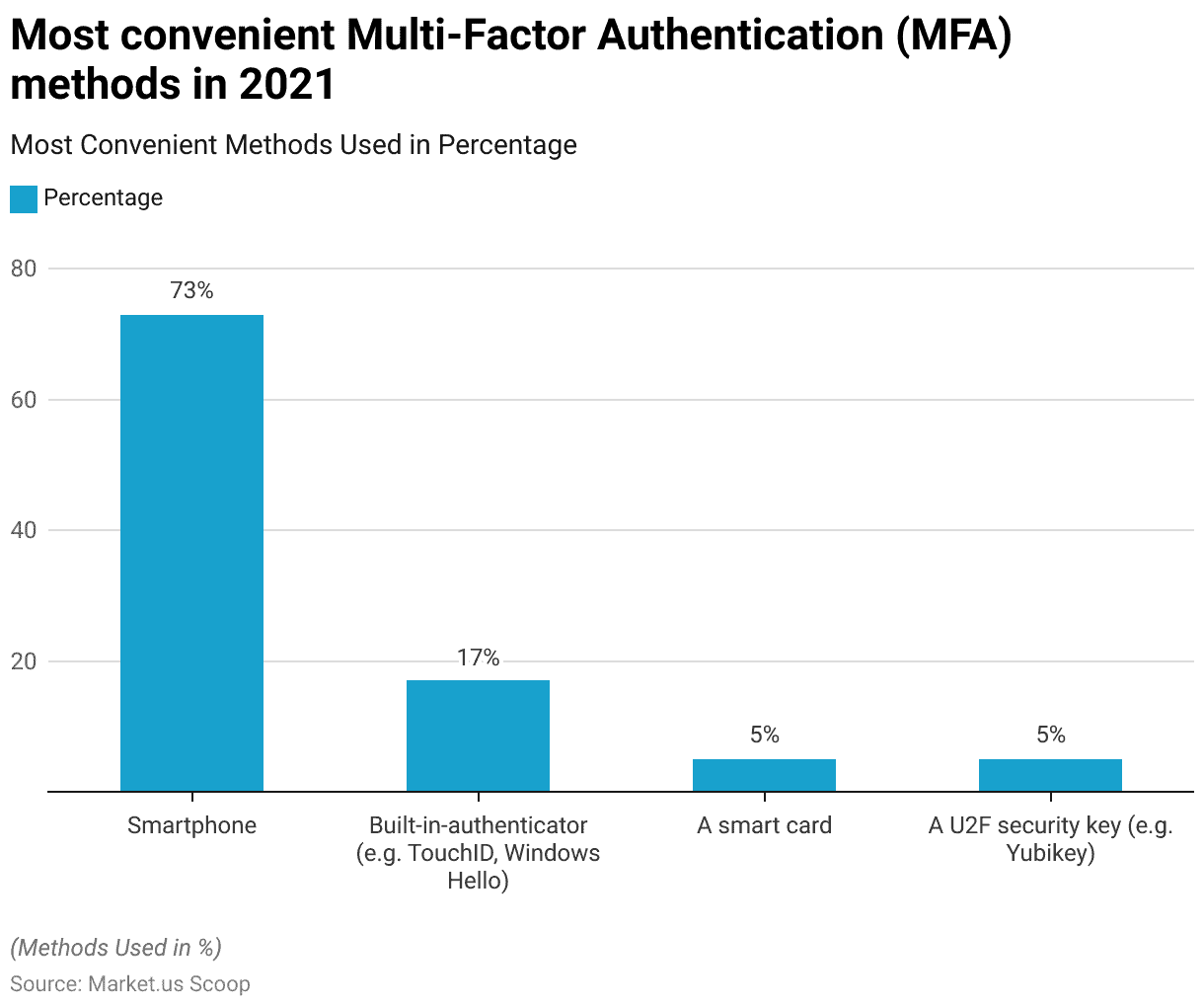
Multi-Factor Authentication Usage in Organizations
- Based on an extensive analysis conducted by LastPass, which encompassed more than 47,000 organizations worldwide utilizing its password management services, it was revealed that 57% of these organizations have embraced multi-factor authentication (MFA). This marks a significant increase of 12 percentage points compared to the previous year’s findings.
- When it comes to MFA usage among employees, a substantial 95% opt for software-based solutions, predominantly mobile apps.
- In contrast, only a mere 4% prefer hardware-based options, and merely 1% rely on biometric methods such as facial or fingerprint recognition.
- Specifically, among employees utilizing MFA with LastPass, the LastPass Authenticator emerged as the preferred choice, with a 39% usage rate.
- Duo Security was the top pick for 31%, while Google Authenticator found favor with 24% of respondents. Additional options included Yubikey (4%) and Microsoft Authentication (1%).
- Furthermore, the likelihood of MFA adoption is closely linked to the size of the organization. In larger companies with over 10,000 employees, a significant 87% employ MFA.
- The adoption rate remains robust at 78% for businesses with 1,001 to 10,000 employees.
- However, in smaller companies with 26 to 100 employees, the rate notably drops to 34%. For businesses with up to 25 workers, the adoption rate is even lower, standing at 27%.
(Source: LastPass)
MFA Usage by Companies Worldwide – By Type Statistics
- In the global landscape of Multi-Factor Authentication (MFA) usage by companies in 2021, several methods were employed to bolster security measures.
- The most prevalent choice was the use of authenticator applications, representing 57.8% of MFA adoption. These applications offer a versatile and secure means of verifying user identities.
- Following closely, SMS codes were utilized by 39.1% of companies, providing a convenient method for delivering authentication codes to users’ mobile devices.
- One-time passwords (OTP) were also popular, with 37.4% of companies relying on this secure and time-sensitive authentication approach.
- Hardware security keys were employed by 30% of companies, enhancing security through physical devices.
- Additionally, secondary email addresses were utilized by 14.7% of companies as an authentication method.
- A smaller percentage, 7.3%, opted for other MFA methods, showcasing the diversity of approaches to enhancing cybersecurity.
- These findings emphasize the widespread recognition of MFA’s significance in safeguarding company data and systems, with companies selecting methods that align with their security needs and operational requirements.
(Source: Statista)
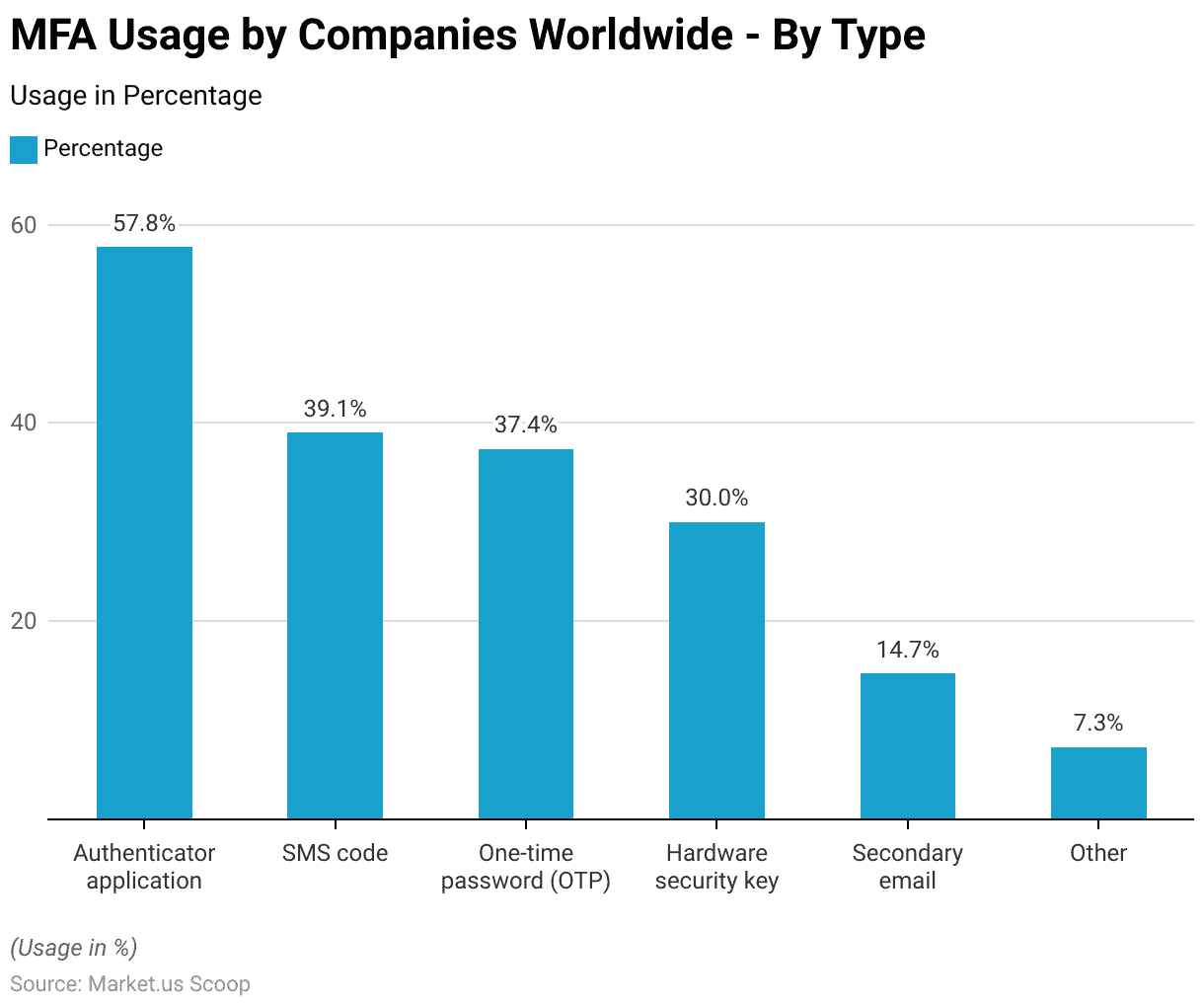
Latest Multi-Factor Authentication Trends Statistics
- Microsoft reports that its systems face more than 1,000 password attacks per second, highlighting the relentless nature of cyber threats.
- Importantly, over 99.9% of compromised accounts lack Multi-Factor Authentication (MFA) protection.
- A majority of individuals hold a favorable view of online platforms implementing Multi-Factor Authentication (MFA).
- Among them, 67% in the United Kingdom believe that services embracing MFA demonstrate a commitment to safeguarding personal data.
- According to a recent Okta survey, the adoption of Multi-Factor Authentication (MFA) is increasing. As of January 2023, nearly two-thirds of users utilize MFA for authentication.
- This trend is even more pronounced among administrators, with 64% of regular users and 90% of administrators employing MFA for added security.
(Source: Microsoft, Statista, Okta)
Multi-Factor Authentication Challenges Statistics
- When you’ve implemented multi-factor authentication (MFA) for your accounts, you’ve made a substantial move in securing your online identity.
- While the ultimate aim is to attain full protection, it’s noteworthy that even among the 28% of users who have activated MFA, attackers continue to target them.
- The presence of MFA prompts attackers to devise more advanced methods to bypass this security measure, resulting in the development of more sophisticated attack techniques.
(Source: Microsoft)
Recent Developments
Acquisitions and Mergers:
- Thales acquires OneWelcome: In 2023, Thales, a global cybersecurity company, acquired OneWelcome, a provider of identity and access management solutions, for $100 million. This acquisition strengthens Thales’ MFA offerings, particularly in securing digital identities and enhancing authentication solutions for businesses.
- Okta acquires Auth0: In early 2023, Okta, a leader in identity management, completed the acquisition of Auth0, an identity platform for developers, for $6.5 billion. This merger aims to integrate Auth0’s developer-centric tools with Okta’s enterprise solutions, enhancing MFA options for businesses of all sizes.
New Product Launches:
- Microsoft introduces passwordless MFA for Azure Active Directory: In late 2023, Microsoft launched a new passwordless multi-factor authentication feature for Azure Active Directory. This new offering allows businesses to adopt biometric-based MFA, such as facial recognition or fingerprint scanning, reducing the reliance on traditional passwords by 35%.
- Google rolls out enhanced MFA for Google Workspace: In early 2024, Google introduced enhanced MFA options for Google Workspace users. The update includes the use of hardware security keys and mobile authentication apps, making it easier for enterprises to secure their accounts and data.
Funding:
- Yubico secures $125 million for MFA innovation: In 2023, Yubico, a leader in hardware security keys, raised $125 million to accelerate the development of its YubiKey MFA devices. The funds will be used to expand into new markets and enhance product capabilities. Including support for FIDO2 authentication standards.
- Beyond Identity raises $100 million for passwordless MFA: In mid-2023, Beyond Identity, a company focusing on passwordless MFA, raised $100 million to expand its MFA solutions for enterprises. This funding will support the integration of biometrics and mobile-based MFA across multiple industries.
Technological Advancements:
- Biometric MFA adoption: By 2025, 45% of MFA implementations will include biometric factors such as fingerprint or facial recognition, enhancing security and convenience for users. This shift is driven by advancements in AI-powered authentication technologies.
- AI and behavioral analytics in MFA: Behavioral analytics is becoming an integral part of MFA. By 2026, 40% of MFA solutions are expected to use AI-driven behavioral analytics to detect anomalies in user behavior, further securing systems from fraudulent access attempts.
Conclusion
Multi-Factor Authentication Statistics – To sum up, Multi-Factor Authentication (MFA) holds a vital place in contemporary cybersecurity. Its significance in improving access security and shielding valuable information cannot be emphasized enough.
MFA not only bolsters protection but also complies with regulatory standards. While there’s a favorable shift toward its adoption.
There’s still potential for broader use, especially among smaller entities. The enduring risk of cyberattacks underscores the importance of strong authentication methods.
As threat actors adapt, the ongoing advancement and embrace of MFA technologies are crucial to reinforce our online security and prevent unauthorized access and data breaches.
FAQs
Multi-factor authentication is a security method that requires users to provide at least two different authentication factors to access a system or account. These factors can include something you know (like a password), something you have (like a mobile device), or something you are (like a fingerprint).
MFA is crucial because it significantly enhances security by adding an extra layer of protection beyond just a password. It reduces the risk of unauthorized access, data breaches, and identity theft.
Common authentication factors include knowledge factors (passwords, PINs), possession factors (mobile apps, hardware tokens), and biometric factors (fingerprint, facial recognition).
No, MFA is beneficial for organizations of all sizes. While larger entities often adopt it sooner, smaller businesses and individuals can also benefit from MFA’s security advantages.
Some MFA solutions are free, while others may have associated costs for premium features or services. It depends on the provider and the level of security desired.
Discuss your needs with our analyst
Please share your requirements with more details so our analyst can check if they can solve your problem(s)



